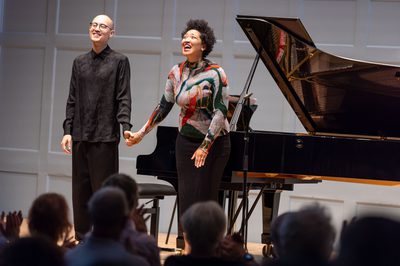
News Story
What do Julia Bullock, Cécile McLorin Salvant and Nickel Creek all have in common? Of course, they all performed song cycles at the 2023 Festival. While song cycles have their routes in classical music, the form has evolved to include almost any genre of music, including jazz and bluegrass.
A song cycle is a collection of songs that are all linked together by a central theme. The theme could be anything but the classics – birth, love and death – are enduringly popular. Song cycles can also be linked by repeated musical motifs or a series of poems or texts. They can range in length from just two songs – which is known as a dyad-cycle – to over 30 songs.
The term 'song cycle' comes from the German word Liederkreis. The term originated in the 19th century, but song cycles had been around without an official name for centuries beforehand. The first example of a song cycle is believed to be a set of seven cantigas de amigo, or friend songs, by the Galician minstrel Martin Codax in the 13th century. In the early 1800s, some of the world’s most influential composers, such as Beethoven, Haydn and Mozart, composed the earliest German Liederkreis. While Beethoven might have created one of the earliest known song cycles with ‘An die ferne Geliebte’, it was Franz Schubert who became the master of the genre.
Although Schubert sadly only lived to be 31, he wrote an impressive number of Lieder (songs) totaling 600 pieces of work. Song cycles were popular during the Romantic period, and themes of longing, emotions, love, and a deep appreciation of the natural world, were perfectly accompanied by music. Schubert was fond of transforming Johann Wolfgang von Goethe’s poetry into songs, including ‘Der Erlkönig’ and ‘Gretchen am Spinnrade’. Lieder are performed by one vocalist and are accompanied by a piano. Both musicians are given equal weight and both are responsible for expressing the poetic nature of the song. Musically, Lieder are known for their dark harmonies, frequent modulations and poetic imagery. This summer, Julia Bullock and Bretton Brown performed a range of German Lieder, including Schubert’s ‘Suleika’ and ‘Rastlose Liebe’ at The Queen’s Hall. Praised for her ‘true and dramatic’ vocals by the Scotsman, Julia Bullock’s performance embodied Lieder at their finest.

Song cycles also developed outside of Germany. French song cycles were pioneered by Hector Berlioz in 1841 with his work ‘Les nuits d'été’, meaning 'the nights of summer'. Song cycles have now been written in many different languages across the world, and some of the most famous in English are Vaughan Williams’s Songs of Travel.
Song cycles are still a form that is often experimented with. They don’t need to be confined to the classical or Romantic musical tradition, and they can cross genre and musical boundaries. While not explicitly known as song cycles, many popular musicians also produce albums that centre around a common theme, with songs that blur into the next track. These are often called rock operas and some of the most famous include Pink Floyd’s concept album The Wall and Marvin Gaye’s album What’s Going On.
There can be many reasons for choosing to adopt a song cycle when creating a new piece of music. In the case of innovative Bluegrass group, Nickel Creek, they wanted to be ‘like one of these great video games where you feel like you're inside of a little world.' For them, a song cycle was a great choice for their album Celebrants. The album was developed to be listened to in its entirety, and each track was designed to influence the track that would play after. The song cycle allowed the trio to explore the theme of human connection more so than an individual song could ever let them.
Although artists have branched out into different genres, there are some modern examples that adhere more closely to song cycle’s classical roots. This August, Cécile McLorin Salvant’s jazz song cycle Ogresse took the audience on a magical journey deep into the belly of a dark wood. The plot was relatively simple; ‘She falls in love. She eats the guy. She dies.’ Accompanied by a 13-piece orchestra of multi-instrumentalists, McLorin Salvant combined jazz, Baroque, folk and country, creating a unique sound that dove into themes of power dynamics, racism, sexism and colonialism. McLorin Salvant ‘always wanted to write a longer narrative story, something that I could tell over the course of a show', exploring the topics of female monstrosity, hunger and fatphobia. Ogresse allowed for this exploration, creating space for multiple characters' points of view in a way that provided both humour and tragedy.
Similarly, contemporary icons of the classical music world continue to embrace song cycles new and old. At the 2021 Festival, the Chineke! Orchestra and Andrea Baker performed the epic song cycle woman.life.song. Much like the canonical Dream of Gerontius, this song cycle charts the course of a whole life, only this time we're following a woman. This piece is a perfect example of how song cycles allow for cross-genre collaboration; American soprano Jessye Norman approached best-selling authors Maya Angelou, Clarissa Pinkola Estés and Toni Morrison to write the lyrics, and British composer Judith Weir then created the music. The adaptability of the form to any subject matter and any musical genre has allowed for continual innovation, while the emotional journey listeners can be taken on through the songs' building momentum gives it longevity, harking all the way back to the emotional and dramatic German Liederkreis.
Which artist would you like to see create their own song cycle? Let us know on social media using #EdIntFest.


